Is CMV a target in pediatric glioblastoma? Expression of CMV proteins, pp65 and IE1-72 and CMV nucleic acids in a cohort of pediatric glioblastoma patients
- PMID: 26341370
- PMCID: PMC4612329
- DOI: 10.1007/s11060-015-1905-z
Is CMV a target in pediatric glioblastoma? Expression of CMV proteins, pp65 and IE1-72 and CMV nucleic acids in a cohort of pediatric glioblastoma patients
Abstract
While the 5-year overall survival is better in pediatric than in adult patients diagnosed with glioblastoma (GBM), outcomes in children remain very poor. Understanding the mechanisms of tumorigenesis and tumor propagation can identify therapeutic targets to improve these outcomes. Human cytomegalovirus (CMV) proteins and nucleic acids are present in the majority of adult GBM. Indeed, CMV is emerging as a potential glioma-associated target for anti-CMV agents and cellular therapeutics. Furthermore, CMV appears to contribute to GBM's malignant phenotype, although its role in tumorigenesis is less certain. In this cohort of 25 serially diagnosed pediatric GBMs, the largest described cohort to date, we used immunohistochemical staining and in situ hybridization to show the presence of CMV antigens pp65 and IE1-72 as well as CMV nucleic acids, respectively. Our cohort indicated either CMV antigen pp65 or IE1-72 was present in approximately 67 % of pediatric GBM samples. The majority of samples stained positive for either CMV antigen showing a cytoplasmic pattern in 25-50 % of cells within the sample at a moderate intensity, while a few samples showed nuclear staining and higher grade/intensity. Of 16 samples where in situ hybridization was performed, 13 (81 %) showed specific staining using a CMV genome specific probe cocktail. ISH positive samples showed high concordance with being pp65 or IE1-72 positive. These findings, paired with the association of CMV expression with poor prognosis and overall survival, indicate the need to further investigate how these antigens are promoting tumor growth and preventing cell death. Also, the expression of these antigens in a majority of tumor tissues should be considered for immunotherapeutic targets in cases of pediatric GBM.
Keywords: CMV; GBM; Glioblastoma; IE1-72; Pediatric; pp65.
Figures
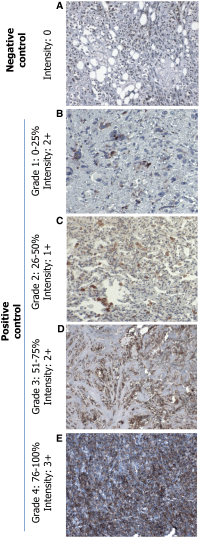
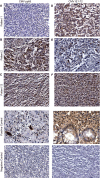
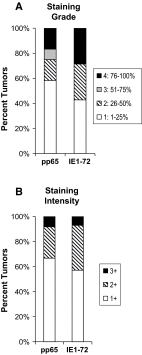
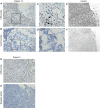
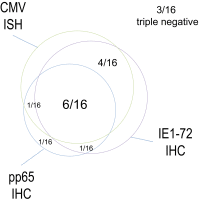
Similar articles
-
The detection of CMV pp65 and IE1 in glioblastoma multiforme.J Neurooncol. 2011 Jun;103(2):231-8. doi: 10.1007/s11060-010-0383-6. Epub 2010 Sep 5. J Neurooncol. 2011. PMID: 20820869
-
Recognition and killing of autologous, primary glioblastoma tumor cells by human cytomegalovirus pp65-specific cytotoxic T cells.Clin Cancer Res. 2014 May 15;20(10):2684-94. doi: 10.1158/1078-0432.CCR-13-3268. Epub 2014 Mar 21. Clin Cancer Res. 2014. PMID: 24658154 Free PMC article.
-
Generation of polyclonal CMV-specific T cells for the adoptive immunotherapy of glioblastoma.J Immunother. 2012 Feb-Mar;35(2):159-68. doi: 10.1097/CJI.0b013e318247642f. J Immunother. 2012. PMID: 22306904 Free PMC article.
-
The next generation recombinant human cytomegalovirus vaccine candidates-beyond gB.Vaccine. 2012 Nov 19;30(49):6980-90. doi: 10.1016/j.vaccine.2012.09.056. Epub 2012 Oct 3. Vaccine. 2012. PMID: 23041121 Review.
-
Progress made towards the development of a CMV peptide vaccine.Hum Immunol. 2004 May;65(5):544-9. doi: 10.1016/j.humimm.2004.02.005. Hum Immunol. 2004. PMID: 15172455 Review.
Cited by
-
A peptide vaccine targeting the CMV antigen pp65 in children and young adults with recurrent high-grade glioma and medulloblastoma: a phase 1 trial.Nat Cancer. 2025 Jun 12. doi: 10.1038/s43018-025-00998-z. Online ahead of print. Nat Cancer. 2025. PMID: 40506525
-
Human Cytomegalovirus DNA Quantification and Gene Expression in Gliomas of Different Grades.PLoS One. 2016 Jul 26;11(7):e0159604. doi: 10.1371/journal.pone.0159604. eCollection 2016. PLoS One. 2016. PMID: 27458810 Free PMC article.
-
The Basis and Advances in Clinical Application of Cytomegalovirus-Specific Cytotoxic T Cell Immunotherapy for Glioblastoma Multiforme.Front Oncol. 2022 Apr 19;12:818447. doi: 10.3389/fonc.2022.818447. eCollection 2022. Front Oncol. 2022. PMID: 35515137 Free PMC article. Review.
-
Cytomegalovirus-Specific Immunotherapy for Glioblastoma Treatments.Brain Tumor Res Treat. 2022 Jul;10(3):135-143. doi: 10.14791/btrt.2022.0010. Brain Tumor Res Treat. 2022. PMID: 35929110 Free PMC article. Review.
-
Tumor Antigens beyond the Human Exome.Int J Mol Sci. 2024 Apr 25;25(9):4673. doi: 10.3390/ijms25094673. Int J Mol Sci. 2024. PMID: 38731892 Free PMC article. Review.
References
Publication types
MeSH terms
Substances
LinkOut - more resources
Full Text Sources
Other Literature Sources
Medical

